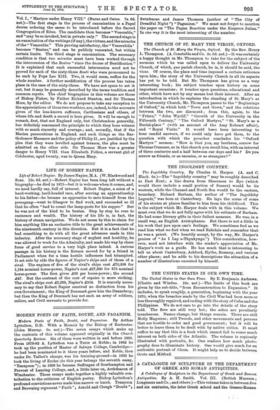VoL I., " Martyrs under Henry VIII." (Burns and Oates.
7s. 6d. net.)—The first stage in the process of canonisation is a Papal decree ordering the cause to be introduced before the Sacred Congregation of Rites. The candidate then becomes "Venerable," and "may be so invoked, but in private only." The second stage is an examination of the writings (if any), the virtues, and the miracles of the "Venerable." This proving satisfactory, the" Venerabilis ' becomes "Beatus," and can be publicly venerated, but within certain limits. The third stage is canonisation. The necessary condition is that two miracles must have been worked through the intercession of the Beatus "since the decree of Beatification." It is explained that such successful intercession need not be proved for each of the sixty-three Beati who were pronounced to be such by Pope Leo XIII. Two, it would seem, suffice for the whole number. A further modification of the process has taken place in the case of the sixty-three. We have not space to set it out, but it may be generally described by the terms tradition and common repute. The chief biographies in this volume are those of Bishop Fisher, by Father Richard Stanton, and Sir Thomas More, by the editor. We do not propose to take any exception to the appreciations of these two worthies, nor, indeed, to the accounts given of the less-known sufferers, Carthusians and others, of whose life and death a record is here given. It will be enough to remark, first, that not England only, but Christendom generally, has definitely renounced the principle to which they bore witness with so much sincerity and courage ; and, secondly, that if the Marian persecutions in England. and such things as the Bar- tholomew Massacre and the policy of Philip II., are justified by the plea that they were levelled against treason, the plea must be admitted on the other side. Sir Thomas More was a greater danger to Henry VIII. than Elizabeth Folkes, a servant girl of Colchester, aged twenty, was to Queen Mary.



























































 Previous page
Previous page